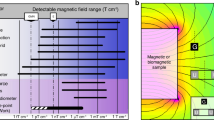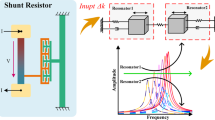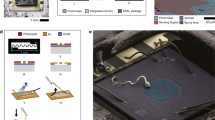Abstract
Small-scale and distortion-free measurement of electric fields is crucial for applications such as surveying atmospheric electrostatic fields, lightning research and safeguarding areas close to high-voltage power lines. A variety of measurement systems exist, the most common of which are field mills, which work by picking up the differential voltage of the measurement electrodes while periodically shielding them with a grounded electrode. However, all current approaches are bulky, suffer from a strong temperature dependency or severely distort the electric field, and thus require a well-defined surrounding and complex calibration procedures. Here we show that microelectromechanical system (MEMS) devices can be used to measure electric field strength without significant field distortion. The purely passive MEMS devices exploit the effect of electrostatic induction, which is used to generate internal forces that are converted into an optically tracked mechanical displacement of a spring-suspended seismic mass. The devices exhibit resolutions on the order of 100 V m−1 Hz−1/2 with a measurement range of up to tens of kilovolts per metre in the quasi-static regime ≲300 Hz). We also show that it should be possible to achieve resolutions of around 1 V m−1 Hz−1/2 by fine-tuning the sensor embodiment. These MEMS devices are compact and could be mass produced easily for wide application.
This is a preview of subscription content, access via your institution
Access options
Access Nature and 54 other Nature Portfolio journals
Get Nature+, our best-value online-access subscription
$29.99 / 30 days
cancel any time
Subscribe to this journal
Receive 12 digital issues and online access to articles
$119.00 per year
only $9.92 per issue
Buy this article
- Purchase on Springer Link
- Instant access to full article PDF
Prices may be subject to local taxes which are calculated during checkout




Similar content being viewed by others
References
Hill, D. A. & Kanda, M. The Measurement, Instrumentation, and Sensors Handbook XXV, Section 47, Electric Field Strength (ed. Webster, J. G.) (CRC Press, Boca Raton, FL, 1999).
Kirkham, H. On the measurement of stationary electric fields in air. Conf. Precision Electromagnetic Measurements (2002); https://trs-new.jpl.nasa.gov/handle/2014/11802
Vasa, N., Kawata, Y., Tanaka, R. & Yokoyama, S. Development of an electric field sensor based on second harmonic generation with electro-optic materials. J. Mater. Process. Technol. 185, 173–177 (2007).
Meier, T., Kostrzewa, C., Petermann, K. & Schuppert, B. Integrated optical E-field probes with segmented modulator electrodes. J. Lightwave Technol. 12, 1497–1503 (1994).
Williams, K., De Bruyker, D., Limb, S., Amendt, E. & Overland, D. Vacuum steered-electron electric-field sensor. J. Microelectromech. Syst. 23, 157–167 (2014).
Ando, B., Baglio, S., Marletta, V. & Bulsara, A. R. A nonlinear electric field sensor that exploits coupled oscillator dynamics: the charge collection mechanism. IEEE Trans. Instrum. Meas. 62, 1326–1333 (2013).
Berthelier, J. J. et al. ICE, the electric field experiment on DEMETER. Planet. Space Sci. 54, 456–471 (2006).
Peng, C., Yang, P., Zhang, H., Guo, X. & Xia, S. Design of a novel closed-loop SOI MEMS resonant electrostatic field sensor. Proc. Eng. 5, 1482–1485 (2010).
Pierce, E. T. Atmospheric electricity—some themes. Bull. Am. Meteorol. Soc. 55, 1186–1194 (1974).
Williams, E. & Mareev, E. Recent progress on the global electrical circuit. Atmos. Res. 135–136, 208–227 (2014).
Zhang, B., Wang, W. & He, J. Impact factors in calibration and application of field mill for measurement of DC electric field with space charges. CSEE J. Power Energy Syst. 1, 31–36 (2015).
Horenstein, M. N. & Stone, P. R. A micro-aperture electrostatic field mill based on MEMS technology. J. Electrostat. 51–52, 515–521 (2001).
Peng, C., Chen, X., Bai, Q., Luo, L. & Xia, S. A novel high performance micromechanical resonant electrostatic field sensor used in atmospheric electric field detection. 19th IEEE Int. Conf. Micro Electro Mechanical Systems 2006, 698–701 (IEEE, 2006).
Kalinowski, D., Redlich, S. & Jager, D. Novel micromachined fiber-optic E-field sensor. IEEE Lasers and Electro-Optics Society 1999 12th Annual Meeting Vol. 1, 385–386 (IEEE, 1999).
Rogers, A. J. Optical measurement of current and voltage on power systems. IEE J. Electric Power Appl. 2, 120–124 (1979).
Soref, R. A. & Bennett, B. Electrooptical effects in silicon. IEEE J. Quantum Electron. 23, 123–129 (1987).
Toney, J. E. et al. in Proc. SPIE 8519, Nanophotonics and Macrophotonics for Space Environments VI (eds Taylor, E. W. et al.) 851904 (SPIE, Bellingham, Washington, 2012).
Berger, J., Petermann, K., Fähling, H. & Wust, P. Calibrated electro-optic E-field sensors for hyperthermia applications. Phys. Med. Biol. 46, 399 (2001).
Barthod, C., Passard, M., Fortin, M., Galez, C. & Bouillot, J. Design and optimization of an optical high electric field sensor. 2000 Conf. Precision Electromagnetic Measurements Digest 423–424 (2000).
Chmielak, B. et al. Pockels effect based fully integrated, strained silicon electro-optic modulator. Opt. Express 19, 17212–17219 (2011).
Zeng, R., Wang, B., Niu, B. & Yu, Z. Development and application of integrated optical sensors for intense E-field measurement. Sensors 12, 11406–11434 (2012).
Bohnert, K., Gabus, P., Brändle, H. & Khan, A. Fiber-optic current and voltage sensors for high-voltage substations. Proc. 16th Int. Conf. Optical FiberSensors 13–17 (Nara, Japan, 2003).
Landau, L., Lifshitz, E. & Piaevski, L. Electrodynamics of Continuous Media (Butterworth-Heinemann, Oxford, UK, 1984).
Hortschitz, W. et al. An optical in-plane MEMS vibration sensor. IEEE Sens. J. 11, 2805–2812 (2011).
Hortschitz, W. et al. MOEMS vibration sensor for advanced low-frequency applications with pm resolution. Proc. Eng. 87, 835–838 (2014).
Middlemiss, R. et al. Measurement of the Earth tides with a MEMS gravimeter. Nature 531, 614–617 (2016).
Zhang, W.-M., Yan, H., Peng, Z.-K. & Meng, G. Electrostatic pull-in instability in MEMS/NEMS: a review. Sens. Actuat. A 214, 187–218 (2014).
Boyd, E. J., Li, L., Blue, R. & Uttamchandani, D. Measurement of the temperature coefficient of Young’s modulus of single crystal silicon and 3C silicon carbide below 273 K using micro-cantilevers. Sens. Actuat. A 198, 75–80 (2013).
Encke, J. et al. A miniaturized linear shaker system for MEMS sensor characterization. Proc. SPIE 8763, SmartSensors, Actuators, and MEMS VI 8763, 876315–876315 (2013); http://dx.doi.org/10.1117/12.2017405
Hortschitz, W. et al. Robust precision position detection with an optical MEMS hybrid device. IEEE Trans. Indust. Electron. 59, 4855–4862 (2012).
Hortschitz, W. et al. Optimized hybrid MOEMS sensors based on noise considerations. Proc. IEEE Sensors https://doi.org/10.1109/ICSENS.2012.6411322 (2012).
Hortschitz, W. et al. Receiver and amplifier optimization for hybrid MOEMS. Proc. IEEE Sensors https://doi.org/10.1109/ICSENS.2012.6411179 (2012).
Kainz, A. et al. Accurate analytical model for air damping in lateral MEMS/MOEMS oscillators. Sens. Actuat. A 255, 154–159 (2017).
Acknowledgements
This work was supported financially by the Austrian Science Fund (FWF, research grant P 28404-NBL), the European Regional Development Fund (ERDF) and the Province of Lower Austria. The authors thank G. Diendorfer for discussions and his support on acquiring the funding for this work.
Author information
Authors and Affiliations
Contributions
A.K., H.S. and W.H. carried out the design, modelling and measurements. J.S. and A.J. were responsible for manufacturing the device, while F.Ko., M.S. and F.Ke. supported the measurements and the design of the devices. R.B. supported modelling and was involved in acquiring funding for the work. All authors contributed to the manuscript.
Corresponding author
Ethics declarations
Competing interests
The authors declare no competing financial interests.
Additional information
Publisher’s note: Springer Nature remains neutral with regard to jurisdictional claims in published maps and institutional affiliations.
Supplementary information
Supplementary Information
Supplementary Figures 1–7
Rights and permissions
About this article
Cite this article
Kainz, A., Steiner, H., Schalko, J. et al. Distortion-free measurement of electric field strength with a MEMS sensor. Nat Electron 1, 68–73 (2018). https://doi.org/10.1038/s41928-017-0009-5
Received:
Accepted:
Published:
Issue Date:
DOI: https://doi.org/10.1038/s41928-017-0009-5
This article is cited by
-
Integrated microcavity electric field sensors using Pound-Drever-Hall detection
Nature Communications (2024)
-
A simulation study verified by experimental test results for frequency response analysis of MEMS comb-drive resonator
Microsystem Technologies (2023)
-
Überblick über ausgewählte Technologieprojekte am Institut für Allgemeine Elektrotechnik und den Nachfolgeinstituten an der TU Wien im Zeitraum 1972–2022
e & i Elektrotechnik und Informationstechnik (2022)
-
Realistic 3D implementation of electrostatic elements for low energy machines
Hyperfine Interactions (2019)
-
Distortion-free probes of electric field
Nature Electronics (2018)



